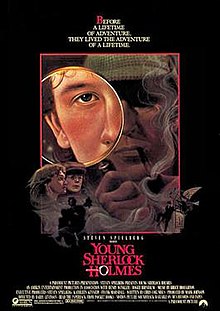
A Study in Scarlet is an 1887 detective novel by British writer Arthur Conan Doyle. The story marks the first appearance of Sherlock Holmes and Dr. Watson, who would become the most famous detective duo in English literature. The book's title derives from a speech given by Holmes, a consulting detective, to his friend and chronicler Watson on the nature of his work, in which he describes the story's murder investigation as his "study in scarlet": "There's the scarlet thread of murder running through the colourless skein of life, and our duty is to unravel it, and isolate it, and expose every inch of it."
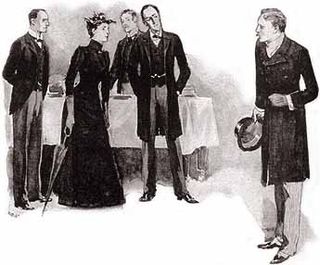
"The Adventure of the Noble Bachelor", one of the 56 short Sherlock Holmes stories written by Sir Arthur Conan Doyle, is the tenth of the twelve stories collected in The Adventures of Sherlock Holmes. The story was first published in The Strand Magazine in April 1892.

Detective Inspector G. Lestrade, or Mr. Lestrade, is a fictional character appearing in several of the Sherlock Holmes stories written by Arthur Conan Doyle. Lestrade's first appearance was in the first Sherlock Holmes story, the novel A Study in Scarlet, which was published in 1887. The last story in which he appears is the short story "The Adventure of the Three Garridebs", which was first published in 1924 and was included in the final collection of Sherlock Holmes stories by Doyle, The Case-Book of Sherlock Holmes.

A Study in Terror is a 1965 British thriller film directed by James Hill and starring John Neville as Sherlock Holmes and Donald Houston as Dr. Watson. It was filmed at Shepperton Studios, London, with some location work at Osterley House in Middlesex.

Without a Clue is a 1988 British comedy film directed by Thom Eberhardt and starring Michael Caine and Ben Kingsley. It is based on Sir Arthur Conan Doyle's characters from the Sherlock Holmes stories but, in this version, the roles are reversed: Dr. John Watson is the brilliant detective, while "Sherlock Holmes" is an actor hired to pose as the detective so that Watson can protect his reputation as a physician.

Sherlock Holmes is the overall title given to the series of Sherlock Holmes adaptations produced by the British television company Granada Television between 24 April 1984 and 11 April 1994.
Sherlock Holmes and the Case of the Silk Stocking is a British television film originally broadcast on BBC One in the UK on 26 December 2004. Produced by Tiger Aspect Productions, it was written by Allan Cubitt and was a sequel to the same company's adaptation of The Hound of the Baskervilles, made for the BBC two years previously. Although Silk Stocking retained the same Dr. Watson, Ian Hart, this time the character of Sherlock Holmes was played by Rupert Everett.

The Hound of the Baskervilles is a 1981 Soviet television film adaptation of Arthur Conan Doyle's 1902 novel The Hound of the Baskervilles. It was the third instalment in the TV series about adventures of Sherlock Holmes and Doctor Watson.
Many writers make references to Sir Arthur Conan Doyle's famous literary creation, the detective Sherlock Holmes, and these often become embedded within popular culture. While Holmes exists predominantly in the context of Victorian-era London, he has been mentioned in such outre contexts as the 22nd century or hunting aliens or supernatural enemies. These references are in addition to the innumerable passing references to Sherlock Holmes made in many literary and cinematic works, such as the labeling of a person as a "Sherlock", whether in reference to their intelligence.

Sherlock Holmes Faces Death is the sixth film in the Basil Rathbone/Nigel Bruce series of Sherlock Holmes films. Made in 1943, it is a loose adaptation of Sir Arthur Conan Doyle's 1893 Holmes short story "The Adventure of the Musgrave Ritual". Its three immediate predecessors in the film series were World War II spy adventures with Holmes and Dr. Watson helping the Allies thwart enemy agents, but this one marked a return to the pure mystery film form. Though several characters are military men and there are frequent mentions of the ongoing war, it is not the focus of the story.

Silver Blaze is a 1937 British, black-and-white crime and mystery film, based loosely on Arthur Conan Doyle's 1892 short story "The Adventure of Silver Blaze". It was directed by Thomas Bentley, and was produced by Twickenham Film Studios Productions. It stars Arthur Wontner as Sherlock Holmes, and Ian Fleming as Dr. Watson. In the United States, the film was released in 1941 by Astor Pictures, where it was also known as Murder at the Baskervilles, retitled by distributors to capitalize on the success of the Basil Rathbone Holmes film, The Hound of the Baskervilles.

The Triumph of Sherlock Holmes is a 1935 British mystery film directed by Leslie S. Hiscott and starring Arthur Wontner. It was based on the 1915 Sherlock Holmes novel The Valley of Fear by Arthur Conan Doyle.

Sir Arthur Conan Doyle's Sherlock Holmes, also known simply as Sherlock Holmes, is a 2010 British-American steampunk mystery film directed by Rachel Lee Goldenberg and produced by independent American film studio The Asylum. It features the Sherlock Holmes characters created by Sir Arthur Conan Doyle, though it follows an original plot. The film details an unrecorded case in which eccentric detective Holmes and his companion Dr. Watson investigate a series of unusual monster attacks and a plot to destroy London. Gareth David-Lloyd plays Dr. John Watson and Ben Syder, making his film debut, plays Sherlock Holmes.
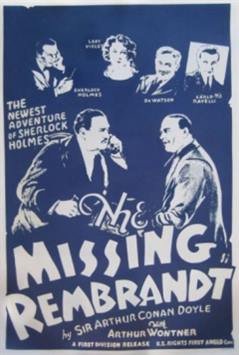
The Missing Rembrandt is a 1932 British mystery film directed by Leslie S. Hiscott and starring Arthur Wontner, Jane Welsh, Miles Mander, and Francis L. Sullivan. It is considered a lost film. The film was loosely based on the 1904 Sherlock Holmes story "The Adventure of Charles Augustus Milverton" by Arthur Conan Doyle.
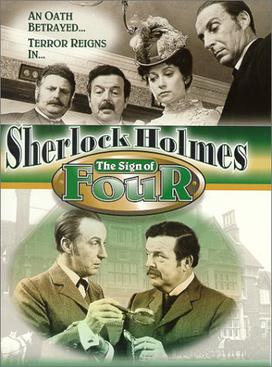
The Sign of Four is a 1983 British made-for-television mystery film directed by Desmond Davis and starring Ian Richardson and David Healy. The film is based on Sir Arthur Conan Doyle's 1890 novel of the same name, the second novel to feature Sherlock Holmes and Doctor Watson.

The Hound of the Baskervilles is a 1983 British made-for-television mystery thriller film directed by Douglas Hickox, starring Ian Richardson as Sherlock Holmes and Donald Churchill as Dr. John H. Watson. It is based on Arthur Conan Doyle's 1902 novel The Hound of the Baskervilles.
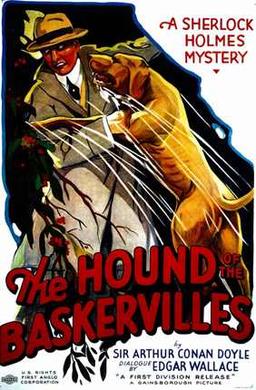
The Hound of the Baskervilles is a 1932 British mystery film directed by Gareth Gundrey and starring John Stuart, Robert Rendel and Frederick Lloyd. It is based on the 1902 novel The Hound of the Baskervilles by Arthur Conan Doyle, in which Sherlock Holmes is called in to investigate a suspicious death on Dartmoor. It was made by Gainsborough Pictures. The screenplay was written by Edgar Wallace.

The Hound of the Baskervilles is a 1921 British silent mystery film directed by Maurice Elvey and starring Eille Norwood, Catina Campbell and Rex McDougall. It is based on the 1902 Sherlock Holmes novel The Hound of the Baskervilles by Arthur Conan Doyle. It was made by Stoll Pictures, Britain's largest film company at the time. It was the first British film adaptation of the famous novel.
The Hound of London is a television film directed by Peter Reynolds-Long and starring Patrick Macnee as Arthur Conan Doyle's character Sherlock Holmes.
